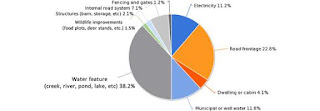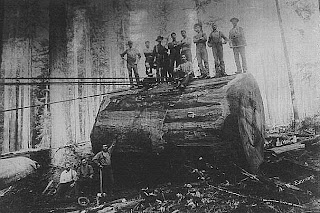I got interested in this tree while camping up in the Smokey Mountain National Park. I bought a book about all the logging railroads in the Appalachian mountains and it had lots of info about this magnificent tree. Look carefully at these pictures and notice the size of the people relative to the tree. These tree were a large part of the forest ecosystem in the Appalachians and provided jobs, lumber, fences, roof shakes and an abundance of mast for wildlife!
Scientists
are on the brink of engineering a blight-resistant American chestnut tree,
renewing hope for a comeback of a long-celebrated species that is valued by
business for its sturdy hardwood. This magnificent tree once covered the
Appalachian mountain range.
For
the first time, techniques used to genetically engineer sturdier farm crops are
being tapped to bring back a devastated native species—one that once numbered
in the billions and covered much of the East Coast. Entire forests were laid to
waste by an Asian fungus introduced around 1900, and healthy chestnuts now
exist only in a smattering of places in the American West, where the blight
didn't reach. Now, chestnut trees whose lives began as smudges on a Petri dish
are growing in upstate New York, their genes infused with a wheat DNA that
appears to kill the fungus that attacks the tree's trunk and limbs. Unlike
chestnuts in nature, these trees haven't succumbed so far to the blight—even
when scientists directly infect them with it.
The
experiments are the culmination of decades of research by scientists at the
State University of New York College of Environmental Science and Forestry in
Syracuse. At the same time, a separate effort was under way to splice the
American chestnut with a Chinese version, producing a potentially
blight-resistant tree dubbed the "Restoration chestnut." Both efforts
have given hope to supporters who want the chestnut to reclaim part of its
share of the forest.

It
remains to be seen whether scientists and foresters can replenish the American
chestnut to its once glorious, widespread population, as the trees will take
decades to mature. In addition to the tree's strong wood being used for barns,
shingles and telephone poles, the tree's nuts sustained forest animals and were
sold throughout Appalachia. "It was
a cornerstone species," said Stacy Clark, a research forester for the U.S.
Forest Service. "It was probably the most versatile tree in the
woods."The American chestnut tree, which has saw-teeth-edged leaves,
shouldn't be confused with horse- or buckeye-chestnut trees, which come from
separate tree families and produce inedible nuts.
The
Asian fungus that crippled the species was first detected in New York's Bronx
Zoo in 1904. The disease starved the tree of water and nutrients and spread
rapidly despite a quarantine effort. By 1940, billions of trees had died. Attempts to restore the American chestnut
began in the 1930s, when scientists unsuccessfully tried to breed the tree with
a Chinese variety that was immune to the fungus. Federal funding dried up by
the 1960s.The efforts were picked up again in the 1980s by scientists and plant
lovers who founded the American Chestnut Foundation. They applied a new method,
called backcross breeding, which was first used for corn that imparts
preferable traits over several generations.
The
foundation started planting their new chestnuts—one-sixteenth Chinese and the
rest American—in Virginia in 2006. More than 100,000 of the trees are growing
across 19 states. with plans for millions more in what the group calls the
country's largest ecological restoration effort. Thousands of trees were
inoculated with the fungus in June 2011, with 20% showing strong resistance and
40% with a more moderate amount, foundation president Bryan Burhans said.
Scientists will select for the strongest resistances when breeding future
generations, he said.
Meanwhile,
scientists at Syracuse's forestry college began experimenting in 1990 with a
technique called transgenics, which was traditionally used to create
genetically modified crops. They inserted a fungus-resistant wheat gene into an
American chestnut embryo and grew a tree from a single cell in a Petri dish. By
2006, Syracuse scientists had planted the first genetically modified trees, and
they hope to gather their first nut crop this fall. The results are promising
so far, as the trees haven't succumbed to blight halfway into the study. We are
all hopeful that these efforts are successful in bring back this wonderful
tree!
For
Information on Buying or Selling Land contact G. Kent Morris, ALC, RF
at (706) 457-0090













